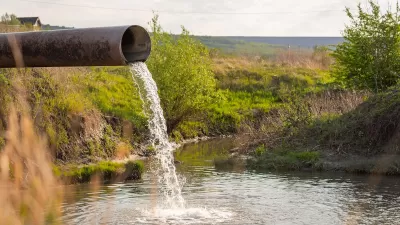Three decades after it was established, the EPA's Superfund program is taking on some of the most complex and costly projects ever attempted. With many focused underwater, some worry the stirring up of polluted sediment will exacerbate the problem.
After decades, and centuries in some places, of acting as a toxic dumping ground, America's rivers and riverfronts have been the targets of cleanup efforts by the federal government's Superfund program. But as the EPA tackles some of the most "complex cleanups ever attempted," located in "large stretches of urban waterways where the pollution is out of sight," doubts remain about the best method to handle such immense efforts, reports Anthony DePalma.
DePalma's article chronicles accounts of well-intentioned cleanup efforts gone wrong. And although many do, in fact, improve the safety of targeted sites, they can stir up waste in the process, threatening the surrounding ecosystem. Still, the federal government is pushing ahead with the Superfund program, utilizing new cleanup technologies and computer modeling.
FULL STORY: Superfund Cleanup Stirs Troubled Waters

Alabama: Trump Terminates Settlements for Black Communities Harmed By Raw Sewage
Trump deemed the landmark civil rights agreement “illegal DEI and environmental justice policy.”

Planetizen Federal Action Tracker
A weekly monitor of how Trump’s orders and actions are impacting planners and planning in America.

The 120 Year Old Tiny Home Villages That Sheltered San Francisco’s Earthquake Refugees
More than a century ago, San Francisco mobilized to house thousands of residents displaced by the 1906 earthquake. Could their strategy offer a model for the present?

In Both Crashes and Crime, Public Transportation is Far Safer than Driving
Contrary to popular assumptions, public transportation has far lower crash and crime rates than automobile travel. For safer communities, improve and encourage transit travel.

Report: Zoning Reforms Should Complement Nashville’s Ambitious Transit Plan
Without reform, restrictive zoning codes will limit the impact of the city’s planned transit expansion and could exclude some of the residents who depend on transit the most.

Judge Orders Release of Frozen IRA, IIJA Funding
The decision is a victory for environmental groups who charged that freezing funds for critical infrastructure and disaster response programs caused “real and irreparable harm” to communities.
Urban Design for Planners 1: Software Tools
This six-course series explores essential urban design concepts using open source software and equips planners with the tools they need to participate fully in the urban design process.
Planning for Universal Design
Learn the tools for implementing Universal Design in planning regulations.
Clanton & Associates, Inc.
Jessamine County Fiscal Court
Institute for Housing and Urban Development Studies (IHS)
City of Grandview
Harvard GSD Executive Education
Toledo-Lucas County Plan Commissions
Salt Lake City
NYU Wagner Graduate School of Public Service





























